
Seligman is a census-designated place (CDP) on the northern border of Yavapai County, in northwestern Arizona, United States. The population was 456 at the 2000 census.
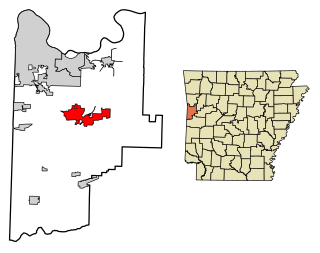
Greenwood is a city in and one of the two county seats of Sebastian County, Arkansas, United States. It is the fifth largest municipality in the Fort Smith, Arkansas-Oklahoma Metropolitan Statistical Area with a population of 8,952 according to the 2010 US Census. According to estimates based on the most recent census, the population of Greenwood in 2018 was 9,397.

There are eight properties listed on the National Register of Historic Places (NRHP) in Linn County, Kansas. Two of the sites are the location of historic events. The Marais des Cygnes Massacre Site is the location of the Marais des Cygnes massacre, an 1858 event during Bleeding Kansas in which pro-slavery advocates kidnapped 11 anti-slavery settlers, killing five of them. John Brown temporarily used the site as a fort, and the property was listed on the NRHP in 1971. The Battle of Mine Creek Site preserves the location of the Battle of Mine Creek, which was fought in 1864 as part of Price's Raid during the American Civil War. Confederate general Sterling Price's army was retreating after being defeated at the Battle of Westport and was attacked by pursuing Union troops. Price's Confederate lost heavily in men and supplies. The site was added to the NRHP in 1973.

The Scott County Jail is the main detention facility for Scott County, Iowa, United States. Inmates are housed for no more than one year, by Iowa law. It is located in the county seat, Davenport, and is part of same facility as the Scott County Courthouse.
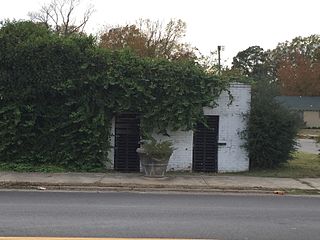
The former McGehee City Jail is a historic building at South First and Pine Streets in McGehee, Arkansas. The small single story brick building was built in 1908, and served as the city jail until 1935. The building's roof is made of concrete, and it has three cells, each with a separate outside door. All openings in the building are covered with heavy metal bars, and the doors are solid metal. Even though this building has sat vacant since 1935, it has survived the jail that was built to replace it.
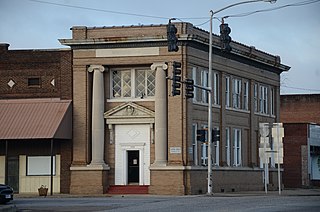
The Prescott Commercial Historic District encompasses the historic commercial core of Prescott, Arkansas, the county seat of Nevada County. Prescott was laid out in 1873, after the railroad was built through the area that is now Nevada County, and the railroad has played a significant role in the city's development. The railroad today bisects the commercial core of the city, which extends for several city blocks away from the railroad. The historic district includes all of the major civic buildings of the city, including the courthouse, post office, and the old Prescott City Jail.
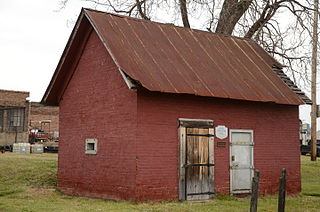
The Gurdon Jail is a historic city jail at West Joslyn and Front Streets in Gurdon, Arkansas. The single-story brick building, which contains two cells, was built in 1907 by the co-owner of the local brick company, M.D. Lowe. It is the only such structure in the city, and is one of a few surviving buildings from Gurdon's boom time as a lumber town in the early 20th century.

The New Rocky Comfort Jail is a historic jail, located at the southeast corner of 3rd and Schuman Streets in Foreman, Arkansas. It is a single story wooden structure, resting on concrete block piers and topped by a metal gable roof. Its walls are constructed out of stacked two-by-six pine, and its floor and ceiling are out of similar material, laid on edge. The main rectangular block was built in 1902, and an entry vestibule was added to the south side sometime before 1928. The floor was later covered with a conventional pine floor, and part of the interior was partitioned for an office and bathroom. The building, which has served variously as a jail, city hall, meeting hall, library, and dance hall, now houses the New Rocky Comfort Museum.

The Old Gillett Jail is a historic former city jail at 207 Main Street in Gillett, Arkansas. It is a single-story brick structure, housing two cells and a small entry vestibule. Its windows have vertical iron bars over them, and the door is made of solid metal. The roof is made of metal. It was built in 1922, and served as the city jail until about 1972.

The John H. Johnston Cotton Gin Historic District encompasses a historic cotton gin in the small community of Levesque, Arkansas. The main building of the gin was built in 1941, and was built out of reinforced concrete, instead of the more usual steel, owing to a metal shortage in World War II. It has some Moderne styling, with smooth surfaces and rounded corners. The gin also distinctively incorporates a seed storage facility at its rear. Its ancillary structures, which include a shed, privy, and cyclone structure, are wood-framed with metal siding and roofing.
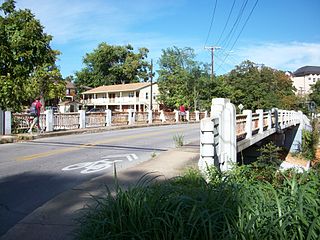
The Lafayette Street Overpass is a historic bridge in Fayetteville, Arkansas. It is a three-span reinforced concrete girder structure, carrying Lafayette Street over the tracks of the St. Louis–San Francisco Railway. The bridge is about 120 feet (37 m) long and 30 feet (9.1 m) wide, and consists of reinforced concrete spans resting on concrete abutments. It features an Art Deco railing, with a metal balustrade covering concrete piers with inset light fixtures. The bridge was built in 1938 by Edward B. Mooney, Inc.

The Old Huntington Jail is a historic jail at 223 East Broadway in Huntington, Arkansas. It is a single-story stone structure, fashioned out of courses of cut stone. It was built in 1888 by the Kansas and Texas Coal Company, a mining concern that platted and founded Huntington in 1887. The interior has a central access space with two small cells on the right, and one large one on the left. The jail was in active use into the mid-1950s, and is now part of a local history museum.
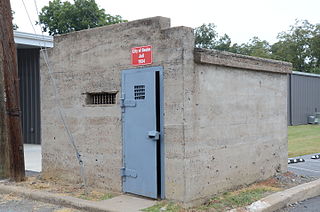
The Beebe Jail is a historic jail building in Beebe, Arkansas. The small single-story concrete structure is set on an alley south of East Illinois Street on the east side of North Main Street. It is distinctive for its slightly rounded concrete roof, with a parapet rising above the front (southwest) facade. The interior has two small cells, each with a barred window, and a small vestibule area. The jail was built as a Works Progress Administration project in 1934.

The Old Searcy County Jail is a historic building on Center Street, on the south side of the courthouse square in Marshall, Arkansas. It is a two-story stone structure, built out of local sandstone, with a pyramidal roof topped by a cupola. The front facade, three bays wide, has a central bay that projects slightly, rising to a gabled top, with barred windows at each level. The main entrance is recessed in the rightmost bay. The building's interior houses jailer's quarters on the ground floor and cells on the upper level. Built in 1902, it was used as a jail until 1976, and briefly as a museum thereafter.

The Russell Jail is a historic town holding facility in Russell, Arkansas. It is located near the town post office, in a field at the junction of West Elm Street and Highway Avenue. It is a small single-story concrete structure, with a slightly bowed roof, a doorway opening on one wall, and small square barred openings on the sides. It was built about 1935 with funding support from the Works Progress Administration, and is one just three such structures in White County.

The Old Logan County Jail is a historic government building at 202 North Vine Street in Paris, Arkansas. It is a two-story brick building, covered by a hip roof with exposed rafter ends. Its main facade has a single-story porch extending across the front. Windows are set in segmented-arch openings, with strap-metal bars set across them in a crosshatch pattern. There are two entrances, one for the jailer's quarters, and one with bars that provides access to the cell block. Built in 1903, it is one of the state's best-preserved early 20th-century county jails. It is the site of the last legal hanging in Arkansas, which took place when John Arthur Tillman, 23, was hung on July 15, 1914, at 7 am for the murder of Amanda Jane Stephens, 19.

The Magazine City Hall-Jail is a historic government building at the northwest corner of Garland and Priddy Streets in Magazine, Arkansas. It is a single-story masonry structure, built out of rusticated concrete blocks and covered by a gable roof. The gable ends are framed in wood. The rear portion of the building, housing the jail cells, has a flat roof. It was built in 1934, with the concrete blocks formed by a local mason to resemble ashlar stone. It is the only local municipal building built out these materials, and was used for its original purposes into the 1980s.

In the United States, a one-room jail is a type of jail with only one room, or cell.






















